Search results
19 results found.
19 results found.
In addition to accepting donations at the school through the drive, McGuire said the kindergarten classes went around the Van Hise neighborhood and collected donations from homes on Wednesday. They first put up posters on Dec. 1 alerting residents to their planned collection event, filling up 10 wagons between the three classes.
“We’re just so proud of them,” McGuire said. “And we’re just so proud of our community, too, for being so supportive.”
Madison taxpayers recently funded the expansion of our least diverse schools, including Van Hise and nearby Hamilton middle schools. This, despite space in nearby facilities.
Several Massachusetts superintendents are spending more money on schools that enroll mostly wealthy students than they are on schools that educate mostly poor students, even though the state designed its funding formula to do the exact opposite. And some schools are outperforming other schools even though they’re receiving significantly less money.
That’s according to a new report by the Massachusetts Business Alliance for Education, which analyzed school-spending data now provided by the state’s department of education under a new ESSA provision.
The data dump comes amid a tense debate at the state capital over how to overhaul the state’s funding formula. Three bills under consideration in the state legislature could provide significantly more money to districts. But the distribution methods and amounts vary widely. All are tangled up in a politically contentious process that’s spurred protests and a lawsuit.
MBAE found that under the current system, districts such as Brockton, Chelmsford and New Bedford, distribute their money between schools in an inconsistent way that often is not targeted toward the state’s neediest students.
“Money isn’t always getting to the students who need it the most,” Edward Lambert Jr., the group’s executive director said in a press release.
Ding Jie, Li Rongde, Su Xin and Zhou Simin:
A group of 30 parents staged a protest at the education department of Beijing’s Dongcheng district earlier in May to voice their opposition to a sweeping change to the “school district” policy now being tested by the local government.
Under the change, a school district, usually comprised of several neighborhoods, is no longer tied to one specific school. Instead, students in one school district can choose from a list of schools close to their homes depending on the availability of spaces at each of the schools.
Madison recently expanded its least diverse schools: Hamilton Middle and Van Hise Elementary.
It’s interesting to consider recent Madison School Board/Administration decisions in light of David Brooks’ 7/11/2017 column:
Over the past generation, members of the college-educated class have become amazingly good at making sure their children retain their privileged status. They have also become devastatingly good at making sure the children of other classes have limited chances to join their ranks.
How they’ve managed to do the first task — giving their own children a leg up — is pretty obvious. It’s the pediacracy, stupid. Over the past few decades, upper-middle-class Americans have embraced behavior codes that put cultivating successful children at the center of life. As soon as they get money, they turn it into investments in their kids.
Upper-middle-class moms have the means and the maternity leaves to breast-feed their babies at much higher rates than high school-educated moms, and for much longer periods.
Upper-middle-class parents have the means to spend two to three times more time with their preschool children than less affluent parents. Since 1996, education expenditures among the affluent have increased by almost 300 percent, while education spending among every other group is basically flat.
As life has gotten worse for the rest in the middle class, upper-middle-class parents have become fanatical about making sure their children never sink back to those levels, and of course there’s nothing wrong in devoting yourself to your own progeny.
Let’s begin with the rejection of the proposed Madison Preparatory Academy IB charter school (which would have operated independently of the current model) and continue to a recent referendum that expanded Madison’s least diverse schools.
Madison has continued to substantially increase tax and spending practices, now approaching $20,000 per student, annually. This is far more than most school districts and continues despite disastrous reading results.
See also Van Hise’s special sauce.
IVY LEAGUE SUMMARY: TAX BREAK SUBSIDIES AND GOVERNMENT PAYMENTS:
KEY FINDINGS:
1. Ivy League payments and entitlements cost taxpayers $41.59 billion over a six-year period (FY2010-FY2015). This is equivalent to $120,000 in government monies, subsidies, & special tax treatment per undergraduate student, or $6.93 billion per year.2. The Ivy League was the recipient of $25.73 billion worth of federal payments during this period: contracts ($1.37 billion), grants ($23.9 billion) and direct payments – student assistance ($460 million).
A look at the history of District 3, which stretches along the West Side of Manhattan from 59th to 122nd Street, shows how administrators’ decisions, combined with the choices of parents and the forces of gentrification, have shaped the current state of its schools, which, in one of the most politically liberal parts of a liberal city, remain sharply divided by race and income, and just as sharply divergent in their levels of academic achievement.
In 1984, two years before Ms. Shneyer started kindergarten, less than 8 percent of the district’s 12,321 elementary and middle school students were white. Not a single school was majority white, and the only school where white students made up the biggest group was P.S. 87 on West 78th Street. At the time, many white parents would not even consider their zoned schools. James Mazza, who served as deputy superintendent, and then superintendent of the district, from 1988 to 1997, recalled in an interview that parents would sometimes come into his office carrying a newspaper with the test scores of every school in the district and explain that they didn’t want to go to their zoned school because of its place on the list. Though scores are often used as a shorthand for quality, they correlate closely with the socioeconomic level of the children in a school.
Ms. Ortiz didn’t think having more white or upper-middle-class parents in the school would necessarily improve it, since she thought that they would mostly push for programs that benefited their own children. She said it seemed that Ms. Castellano-Folk already gave parents in the gifted program preferential treatment.
Others expressed positive feelings about the school.
Curiously, Madison recently expanded its least diverse schools (Van Hise/Hamilton)…..
Laurie Frost and Jeff Henriques, via a kind email:
Dear Superintendent Cheatham and Members of the Madison School Board:
We are writing as an update to our Public Appearance at the December 12 Board meeting. You may recall that at that meeting, we expressed serious concerns about how the District analyzes and shares student data. For many years, it has seemed to us that the District reports data more with an eye towards making itself look good than to genuinely meeting children’s educational needs. As social scientists with more than two decades of involvement with the Madison schools, we have long been frustrated by those priorities.
Our frustration was stirred up again last week when we read the newly released MMSD 2017 Mid- Year Review, so much so that we felt called upon to examine a specific section of the report more closely. What follows is expressly not a critique of the MMSD elementary school in question, its staff, or its students. What follows is solely a critique of what goes on in the Doyle Building.
MMSD 2017 Mid-Year Review and Van Hise Elementary School’s “Special Sauce”
Near the end of the MMSD 2017 Mid-Year Review, there is an excited update on the “extraordinary [student] growth” happening at Van Hise Elementary School:
School Update: Van Hise students and families build on strengths
In last year’s Annual Report, Principal Peg Keeler and Instructional Resource Teacher Sharel Nelson revealed Van Hise Elementary School’s “special sauce,” which helped students achieve extraordinary growth in the Measures of Academic Progress (MAP) assessments. We reported that seventy percent of the school’s African American third through fifth grade students were proficient or advanced and half of third through fifth grade students receiving Special Education services were proficient.
We recently caught up with Principal Keeler and Ms. Nelson to get an update on their students’ progress.
“In the past, we felt that one of our strengths as a school was to hold kids to very high expectations. That continues to be the case. We promote a growth mindset and kids put their best effort toward their goals,” said Principal Keeler. “Our older students are provided a process for reflecting on how they did last time on the MAP assessment. They reflect on areas they feel they need to continue to work on and the goals they set for themselves. They reflect on what parts were difficult and what they can improve upon.”
Nelson discussed the sense of community among Van Hise students and how the Van Hise equity vision encompasses families as partners. “We have a comprehensive family engagement plan. We are working together with our families – all on the same page. The students feel really supported. We’re communicating more efficiently and heading toward the same goals,” Nelson said.
Principal Keeler added, “It’s been a fantastic year, it continues to get stronger.”
We got curious about the numbers included in this update — in part because they are some of the few numbers to be found in the 2017 Mid-Year Review — and decided to take a closer look. All additional numbers used in the analysis that follows were taken from the MMSD website.
As you know, Van Hise is a K-through-5th grade elementary school on Madison’s near west side. In 2015-16, it enrolled 395 students, 5% (20) of whom were African American and 9% (36) of whom received special education services. (Note: These percentages are some of the lowest in the District.) For purposes of explication, let’s say half of each of those groups were in grades K-2 and half were in grades 3-5. That makes 10 African American and 18 special education students in grades three-through-five.
The Mid-Year Review states that in 2015-16, an extraordinary 70% of Van Hise’s African American third-through-fifth grade students were proficient or advanced (in something — why not say what?). But 70% of 10 students is only 7 students. That’s not very many.
The Mid-Year Review also states that in 2015-16, an equally extraordinary 50% of Van Hise’s third- through-fifth grade special education students scored proficient (in something). But again, 50% of 18 students is only 9 students.
To complete the demographic picture, it is important to note that Van Hise is the MMSD elementary school with the lowest rate of poverty; in 2015-16, only 18% of its students were eligible for Free/Reduced Lunch. (Note: The Districtwide average is 50%).
We would argue that this additional information and analysis puts the Van Hise Elementary School update into its proper context … and makes the numbers reported far less surprising
and “extraordinary.”
The additional information also makes the Van Hise “special sauce” – whatever it is they are doing in the school to achieve their “extraordinary” results with African American and special education students – far less relevant for the District’s other elementary schools, schools with significantly higher percentages of African American, low income, and special education students.
In terms of its demographic profile, Van Hise is arguably the most privileged elementary school in Madison. Perhaps, then, its “special sauce” is nothing more than the time-worn recipe of racial, socioeconomic, and other forms of political advantage.
But be that as it may, it is not our main point. Our main objective here has been to provide a clear- cut example of how the MMSD cherry picks its examples and “manages” its data presentation for public relations purposes.
We believe the overarching drive to make the District look good in its glossy reports is a misguided use of District resources and stands as an ongoing obstacle to genuine academic progress for our most disadvantaged and vulnerable students.
The Appendices attached to this report consist of a table and several graphs that expand upon the foregoing text. We hope you will take the time to study them. (When you look at Appendices E and F, you may find yourselves wondering, as we did, what’s going on at Lindbergh Elementary School, where the African American students are performing much better than one would expect, given their demographics? Similarly, you may wonder what’s going on at Randall Elementary School, where the African American students are performing much worse than one would expect?)
Please feel free to contact us with any questions you may have about this analysis. As School Board members, you cannot work effectively on behalf of our community’s children unless you understand the District’s data. We are happy to help you achieve that understanding.
Respectfully,
Laurie Frost, Ph.D.
Jeff Henriques, Ph.D.
APPENDICES
Appendix A: MMSD Elementary School Demographics (2015-16)
Appendix B: Percentage of All Students Scoring Proficient/Advanced on Spring 2016 MAP Testing as a Function of the School’s Poverty Level
Appendix C: Percentage of All Students Scoring Proficient/Advanced on Spring 2016 MAP Testing as a Function of the School’s African American Student Enrollment
Appendix D: Percentage of All Students Scoring Proficient/Advanced on Spring 2016 MAP Testing as a Function of the School’s Special Education Student Enrollment
Appendix E: Percentage of African American Students Scoring Proficient/Advanced on Spring 2016 MAP Testing as a Function of the School’s Poverty Level
Appendix F: Percentage of African American Students Scoring Proficient/Advanced on Spring 2016 MAP Testing as a Function of the School’s African American Student Enrollment
Appendix G: Percentage of Special Education Students Scoring Proficient/Advanced on Spring 2016 MAP Testing as a Function of the School’s Poverty Level
Appendix H: Percentage of Special Education Students Scoring Proficient/Advanced on Spring 2016 MAP Testing as a Function of the School’s Special Education Enrollment
Note:
Appendices B through H utilize Spring 2016 MAP data for MMSD third-through-fifth grade students only. The scores for each school are simple averages of the percentages of students scoring proficient or advanced in reading or math across those three grades. We freely acknowledge that these calculations lack some precision; however, given the data we have access to, they are the best we could do.
Source: https://public.tableau.com/profile/bo.mccready#!/vizhome/MAPResults2015- 16/MAPResultsWithSchool
The Madison School District’s 2016 “Mid Year Review“.
Madison expanded its least diverse schools, including Van Hise, via a recent tax increase referendum.
They’ve waited every morning since, Gunter told The 74 in a recent interview, until the doors open and staff welcomes them warmly inside, trading handshakes and high-fives as music courses through the halls.
Not long ago, though, there was little enthusiasm from students, their families — and staff, for that matter. The pre-K–5 school is located in North Omaha’s Highlander neighborhood, for decades one of the poorest, most segregated and most violent areas in the city of 440,000.
Roughly 97 percent of students qualify for free or reduced-price lunch; about 22 percent are English-language learners, and 29 percent are refugees, higher than the district average in each case, according to 2015–16 data. While students have made gains on state test scores in recent years, the school had long been one of the worst-performing in Omaha, which serves about 52,000 students, and one of the lowest-ranked in Nebraska.
Madison voters recently approved additional tax and spending to expand our least divers schools: Hamilton middle and Van Hise elementary.
THE most important divide in America today is class, not race, and the place where it matters most is in the home. Conservatives have been banging on about family breakdown for decades. Now one of the nation’s most prominent liberal scholars has joined the chorus.
Robert Putnam is a former dean of Harvard’s Kennedy School of Government and the author of “Bowling Alone” (2000), an influential work that lamented the decline of social capital in America. In his new book, “Our Kids”, he describes the growing gulf between how the rich and the poor raise their children. Anyone who has read “Coming Apart” by Charles Murray will be familiar with the trend, but Mr Putnam adds striking detail and some excellent graphs (pictured). This is a thoughtful and persuasive book.
Among the educated elite the traditional family is thriving: fewer than 10% of births to female college graduates are outside marriage—a figure that is barely higher than it was in 1970. In 2007 among women with just a high-school education, by contrast, 65% of births were non-marital. Race makes a difference: only 2% of births to white college graduates are out-of-wedlock, compared with 80% among African-Americans with no more than a high-school education, but neither of these figures has changed much since the 1970s. However, the non-marital birth proportion among high-school-educated whites has quadrupled, to 50%, and the same figure for college-educated blacks has fallen by a third, to 25%. Thus the class divide is growing even as the racial gap is shrinking.
Meanwhile, the Madison School Board & District administration plan to expand Van Hise and Hamilton schools via the April, 2015 referendum.
Hamilton and Van Hise are among Madison’s least diverse schools…..
The plans caused equity concerns among some, especially given that both schools are on the west side of Madison and have lower rates of students of color and students who are socioeconomically disadvantaged. La Follette and Capital high schools later added their own, smaller, capital fundraising campaigns.
Taxpayers funded the expansion of Madison’s least diverse schools a few years ago; Hamilton and Van Hise. This, despite space in nearby schools.
As the Madison School District prepares for an overhaul of its high schools, some parents are questioning how fair it is — and whether it’s a violation of district policy — to let the two more-affluent high schools raise potentially tens of millions in donations to bolster referendum-funded renovations.
Parents, alumni, staff and students at Memorial and West high schools have formed capital campaign committees to raise money for extra projects not included in renovation plans being funded by the $317 million facilities referendum voters approved last fall.
But at a board meeting last week, La Follette parents of former, current and future students urged the board to consider what approving donor-funded projects at Memorial and West will mean for the more economically disadvantaged La Follette and East high schools.
2017: West High Reading Interventionist Teacher’s Remarks to the School Board on Madison’s Disastrous Reading Results
Madison’s taxpayer supported K-12 school district, despite spending far more than most, has long tolerated disastrous reading results.
My Question to Wisconsin Governor Tony Evers on Teacher Mulligans and our Disastrous Reading Results
“An emphasis on adult employment”
Wisconsin Public Policy Forum Madison School District Report[PDF]
Booked, but can’t read (Madison): functional literacy, National citizenship and the new face of Dred Scott in the age of mass incarceration.
The plan didn’t become publicly available until Friday afternoon, when the meeting agenda was posted online.
Does the analysis include space in other facilities? The District expanded some of its least diverse schools (Van Hise and Hamilton) several years ago, when space was available in other nearby schools.
The Madison school district is planning a substantial tax and spending increase referendum in 2020.
Perhaps these funds might support those requirements.
Madison taxpayers spend far more than most K-12 school districts, yetwe have long tolerated disastrous reading results
Allis Elementary currently has no active PTO and its fundraising when it did have one last year was “very, very little,” according to interim principal Sara Cutler. Allis’ percentage of economically disadvantaged students last year was 67.9, according to state Department of Public Instruction data, or higher than the district percentage of 46.1. Allis’ non-white population is 77 percent, higher than the district’s 57.1 percent.
The PTO for Huegel Elementary, with an economically disadvantaged population of 41.4 percent, has an annual budget of around $22,000 a year, according to PTO co-treasurer Tony Parisi. The PTO for Schenk Elementary, whose percentage of poor students is 63.5, has an annual budget of about $6,000, according to president Heather Daniels.
The Lowell Community Organization, the PTO-like group for Lowell Elementary, where I’ve had at least one child enrolled since 2009, has a proposed budget this year of about $14,500. Budgets over the past five years have been in the $8,000 to $14,000 range, according to LCO treasurer Kerry Martin. Lowell’s rate of economically disadvantaged students is 37.3 percent.
Madison recently expanded its least diverse schools (Van Hise Elementary and Hamilton Middle), while tolerating long term, disastrous reading results.
“I want to live in the Hamilton/Van Hise attendance area.” I’ve heard that statement many times over the years. I wondered how that desire might be reflected in real estate activity.
Tap for a larger view. xlsx version.
Happily, it’s easy to keep up with the market using the Bunbury, First Weber, Restaino or Shorewest apps. For the middle schools, I’ll use the First Weber app iOS Android. Next week, I plan to take a look at elementary schools using the Restaino app. I also hope to dive into property tax variation.
Tap the search link on your iPhone, iPad or Android with the First Weber app installed. You can then interact with the data and properties.
Black Hawk Middle School Attendance Area Search. Stats.
Cherokee Middle School Attendance Area Search. Stats.
Hamilton Middle School Attendance Area Search. Stats.
Jefferson Middle School Attendance Area Search. Stats.
O’Keeffe Middle School Attendance Area Search. Stats.
Sennett Middle School Attendance Area Search. Stats.
Sherman Middle School Attendance Area Search. Stats.
Madison’s median household income is $53,933 ($31,659 per capita).
Finally, Madison, via a 2015 referendum, is expanding Hamilton, its least diverse middle school.
** As always, much of the property information beneath these statistics is entered by humans. There may be an occasional mistake… 🙂
Dave Baskerville (7 April 2016)
Mr. Ed Hughes, Member, MMSD Board 4/7/16
Ed, I finally got around to reading your “Eight Lessons Learned” article in the 3/9/16 edition of CT. Interesting/thanks. As you know from our previous discussions, we have similar thinking on some of the MMSD challenges, not on others. For the sake of further dialogue and to continue your tutorial style (‘learned’, ‘not learned’) without my trying to be either facetious or presumptious., let me comment as follows:
LESSON ONE. “It’s Complicated”. Certainly agree, but not an excuse for catching up with the rest of the First World. Did you learn that? Challenges which you rightly say are ’multiyear and multipronged’ become far more complicated when there is not a clearcut, long term direction for a company or system. It seems that every responsible board of private/public or NGO institutions has that responsibility to the CEO (read Superintendant).
You talk of improvement (kaizen), but “better” for the status quo alone is not enough when we have been falling behind for several generations. What you apparently did not learn is that with our global rankings and radical changes in technology and the future world of work, serious transformation of our system is needed?
LESSON TWO. “No Silver Bullet”. There can be 1~3 long term goals, but agree, 426 WI school districts need to figure out in their own ways how to get there. (And where things are measured, they are more often done. Dare you provide, as 300 HSs around the country and 14 in WI have done, the PISA tests for all of our MSN 15 years olds. $15,000 per HS, and indeed, does that ever prod Supt’s, and citizens to set their goals long term and higher! And execute!)
LESSON THREE. “Schools Are Systems”. Agree with Gawande that “a system-wide approach with new skills, data-based, and the ability to implement at scale” is needed. Look at Mayo Clinic where my wife and I spend too much of our time! As you say, a significant cultural shift is required. But what you did not learn is what he said later: “Transformation must be led at the top”. That means clearly articulating for the CEO, staff and public the long term destination point for rigorous achievement and the quantitative means to measure. You did not learn that it does not mean getting involved in the vast HOW of ‘defining the efforts of everyone’, innovation, implementation and details. A good CEO and her team will handle all of that.
LESSON FOUR. “Progress Requires Broad Buy-in”. True. Yet, are you not as a Board getting way into the nitty gritty issues, while at the same time not having a clear long term goal with a Scorecard that not only educators can comprehend but all of us citizens? You did not learn that much of strategy and most all of tactics is not a Board’s prerogative to dwell in/muck around in. But the responsibility to articulate a few goals and a scorecard to vigorously monitor for the broader public is a critical constituency responsibility for the MMSD and the broader buy-in.
LESSON FIVE. “Buy-in can’t be bought”. Agree, many business values are not relevant in education.. But to me , what was not learned from the Zukerberg:Newark disaster was rather that you cannot transform a poorly performing system by simply pouring many more resources and monies into it and enabling/enhancing the status quo. (Believe now in San Francisco, Zuckerberg has learned that as well.)
LESSON SIX. “No substitute for Leadership”. Certainly. That’s why I give you folks a rough time! But your reference to a balance of ‘the best system’ and’ teacher /staff commitment’ is valid. Very much mutually needed for global achievement. And you certainly should be discussing those with Jen, as she sees fit.. But it’s not primarily your Board responsibilities. Again to repeat, by mucking around too much in those Supt. Management, and tactical areas and completely missing the long term, measurable goals/ direction, you have not learned the most critical Board role as I outlined in Lesson One above. In addition where management meets political or union road blocks to substantial progress towards those goals, boards must often step in.
And I would add in most institutions, charisma does not transfer. Milt McPike was a great leader that I’m sure considerably improved the achievement levels at East HS. But is not the Purgolders back to mediocre? If the MMSD Board would have had a transformed system with very clear long term goals for East with a PISA Scorecard that involved the public, I’m betting Milt’s accomplishments would be being built on. If we lose Jen in the next few years, I fear likewise. (Or better, you really challenge her with some 20 year global targets, get out of the way, and maybe she’ll stay with us that long.)
LESSON SEVEN. “Improvement Takes Time”. Of course. But you have simply not learned a sense of urgency. Finland, South Korea, Japan, Shanghai-China, etc….are not going to just watch and wait for 20 years our MMSD kids to catch up. They are all forthrightly after further improvement. Those countries unlike you MMSD Board Members really believe/expect their kids can be trained with the best in the world. Very high expectations! You look at where investment in the world is made…where in the USA millions of jobs lack needed skilled people….why over 65% of the UW-MSN doctoral/ post doc students in almost all of the critical science, engineering and math courses are non-Americans. You have not learned, ED, that a long term direction AND urgency must go together!
LESSON EIGHT. “Incremental progress is good progress”. Agree, lurching about in goals/system approach is not good. A “sustainable school…and coherent approach guided by a system-wide vision…” is good. But as said above, you’ve not learned that your ‘incremental progress’ is not enough! The MMSD approach essentially does not recognize the global job market our kids will walk into. Does not recognize that 20 years hence 65% of the careers now do not exist. ( So only major achievement/competency in the basics {MATH, Science, Reading} will provide some assurance of good work/salaries/further trainability during their lifetime.) That with todays transformation of technology, STEM and blue collar jobs as well as universties will definitely require those kinds of skills for social mobility and self-sufficiency.
That’s it for now. See you at the Club, give me a call if you wish to discuss further,
And either way, best regards,Dave Baskerville (608-259-1233) www.stretchtargets.org.
Much more on Ed Hughes, here.
Unfortunately, Madison’s monolithic, $17K+ per student system has long resisted improvement. We, as a community have tolerated disastrous reading results for decades, rejected the proposed Madison Preparatory IB Charter school and astonishingly, are paying to expand our least diverse schools (Hamilton middle and Van Hise elementary) via a 2015 referendum….
Further reading, from 2005! When all third graders read at grade level or beyond by the end of the year, the achievement gap will be closed…and not before.
2006! “THEY’RE ALL RICH, WHITE KIDS AND THEY’LL DO JUST FINE” — NOT!
Two of the most popular — and most insidious — myths about academically gifted kids is that “they’re all rich, white kids” and that, no matter what they experience in school, “they’ll do just fine.” Even in our own district, however, the hard data do not support those assertions.
When the District analyzed dropout data for the five-year period between 1995 and 1999, they identified four student profiles. Of interest for the present purpose is the group identified as high achieving. Here are the data from the MMSD Research and Evaluation Report from May, 2000:Group 1: High Achiever, Short Tenure, Behaved
This group comprises 27% of all dropouts during this five-year period.
Characteristics of this group:
Finally, a few of these topics arose during a recent school board member/candidate (all three ran unopposed this spring) forum. MP3 audio.
Change is hard and our children are paying a price, as Mr. Baskerville notes.
Rather interesting data from the District’s latest $413,703,424 2015-2016 budget document.
The budget document includes total spending and a good amount of detail.
Tap for a larger view.
Van Hise and Hamilton are Madison’s least diverse schools, yet the District plans to expand their facilities. The staffing differences are rather illuminating, particularly when one considers the effectiveness of increased adult counts…
A PDF version is also available. The District document includes a few per school spending data points. It would be useful to see total spending per school.
Voters just approved a $41 million spending referendum. Now the Madison Metro School District says it needs to cut $10.8 million to cover a deficit. This is after rewarding its unionized teachers and support staff with a 2.5% pay increase in the budget approved late last year.
Who is running this store? Hint: It ain’t the Koch Brothers.
The cuts will require eliminating 110 positions, mostly teachers. How does this help minority achievement?
The school board rushed to ratify union contracts four years ago while protesters were still camping overnight in the State Capitol. The district scheduled a special meeting on a Saturday morning with only the minimally required public notice. I attended that meeting, but the public — the three of us who found the meeting — were not allowed to speak. The contract required no teacher contribution to their generous health insurance coverage.
School districts that took advantage of Act 10 are not laying off teachers.
Madison is paying for this folly by collecting teachers union boss John Matthews’ dues for him. Some of that money finds its way back to finance the school board members’ election campaigns. Sweet deal for the union, wormy apples for the students and their families, self-tapping screws for the taxpayers.
I continue to find it fascinating that Madison plans to expand two of its least diverse schools: Hamilton and Van Hise, despite capacity elsewhere and the District’s long term disastrous reading results.
If approved, the referendum would raise property taxes about $62 on the average $237,678 Madison home for 10 years. The district is still paying off $30 million in referendum debt for the construction of Olson and Chavez elementary schools in the late 2000s, according to the district. The final payment, for the Olson project, is due in 2026.
The aggressive school district campaign to get the word out to voters about the proposal and a community group that has been knocking on doors advocating for its passage have largely been met with very little opposition.
“It’s really quiet,” said board vice president James Howard. “I guess we’ll just have to wait until April 7 to find out” whether it has community support.
Board member T.J. Mertz, who has worked closely with the pro-referendum nonprofit Community And Schools Together, said the board has received about a half-dozen emails questioning the increase in property taxes.
“But there is no organized opposition,” Mertz said. “Whether that’s a function of apathy, the political culture of Madison or the lack of a strong Republican Party (in the city), or whether this is a popular measure, it’s impossible to read in the absence of no organized opposition,” adding that there also has not been a conservative school board candidate in about six years.
The proposal comes at a time when the school district faces at least a $12 million gap in its $435 million operating budget for the 2015-16 school year. The maintenance work and $2 million in technology costs also included in the proposal would ease pressure on the district’s budget, Mertz said.
I emailed Michael Barry to confirm Ms. Beck’s $435,000,000 Madison Schools’ budget number, which is 8% or $32,000,000 higher than the previously discussed $402,000,000 2014-2015 budget. I’ve not heard from Mr. Barry.
That said, pity the poor citizen who wishes to determine total spending or changes over time using the District’s published information.
At a forum this week on the referendum projects, many in the crowd on the city’s near west side focused on property taxes and “what we’re doing to save money,” Silveira said Tuesday in a meeting with the Capital Times editorial board.
“People get confused. They think if we pass the referendum, we won’t have the gap on the operating side,” said Silveira, the current president of the school board who is retiring at the end of her term next month.
In fact, cuts in state funding will contribute to a shortfall that, if voters approve the referendum bond sale, would demand a property tax increase next year of up to nearly 5.2 percent to balance the budget, about 1 percent of which would be due to spending approved by the referendum.
Those projects to expand crowded schools, add accessibility and update mechanical systems, as listed in this article about referendum advocacy and detailed on a school district web page.
The State Journal editorial board endorses this reasonable request.
Madison’s per-pupil spending on schools is more than $1,000 above the state average of about $12,000. That’s mostly due to operational costs, including higher pay and benefits for employees.
Madison property taxes are high, too. That’s partly because the state sends less aid to Madison, based on a formula that penalizes communities with higher property value.
But when it comes to construction, the Madison School District has been conservative. The district with nearly 50 schools and 28,000 students has built only three new schools in the last 45 years.
Moreover, Madison’s debt per student is the lowest among all of the school districts in Dane County, and half the state average, according to district figures. At the same time, interest rates are incredibly low.
The proposed maintenance tax & spending referendum includes plans to expand two of the District’s least diverse schools: Van Hise & Hamilton.
Only 20 Percent Turnout Expected Statewide for Tuesday’s Election.
Maggie Ginsberg interviews Brandi Grayson:
Can you give an example of what you’ve described as “intent versus impact?”
The Behavior Education Plan that the [Madison Metropolitan] school district came up with. The impact is effed up, in so many words, and that’s because the voices that are most affected weren’t considered. It’s like standing outside of a situation and then coming in and telling people what they ought to do and should be doing, according to your experience and perspective, which is totally disconnected from the people you’re talking to and talking at. In order to come up with solutions that are effective, they have to come from the people who are living in it. When I first heard about this Behavior Education Plan, I immediately knew that it was going to affect our kids negatively. But people sitting on that board thought it was an amazing idea; we’ll stop suspensions, we’ll stop expulsions, we’ll fix the school-to-prison pipeline, which is all bullcrap, because now what’s happening is the impact; the school is putting all these children with emotional and behavioral issues in the same classroom. And because of the lawsuit with all the parents suing for advanced placement classes and resources not being added, they’ve taken all the introduction classes away. They can’t afford it. So then our students who may need general science or pre-algebra no longer have that. So then they take all these students who aren’t prepared for these classes and throw them in algebra, throw them in biology and all together in the same class. And you know it’s very intentional because if you have a population of two percent Blacks at a school of two thousand and all the Black kids are in the same class, that is not something that happens by random. And then you have kids like my daughter, who is prepared for school and can do well in algebra, but she’s distracted because she’s placed in a class with all these kids with IEP issues who, based on the Behavior Education Plan, cannot be removed from the classroom. So what does that do? It adds to the gap.
Speaking of education, you’ve mentioned the critical need to educate young Black kids on their own history.
Our children don’t know what’s happening to them in school, when they are interacting in these systems. Whether it’s the system of education, the justice system, the human services system, the system within their own families—that’s programming them to think they’re inferior. We have to educate our kids so they know what they’re dealing with. In Western history, we’re only taught that our relevance and our being started with slavery, but we know as we look back that that’s a lie. That we are filled with greatness and magnificence and if our children can connect the link between who they are and where they’ve come, then they can discover where they’re going. But with that disconnection, they feel hopeless. They feel despair. They feel like this is all life has to offer them and it’s their fault and there’s no way out. We have to begin to reprogram that narrative at kindergarten on up. We have to teach our children the importance of reading and knowledge and educating yourself and not depending on the education of the system because it’s already biased, based on the very nature of our culture.
Related: Brandi Grayson.
Madison’s long term, disastrous reading results. This is the core issue, one that has simmered for decades despite Madison spending double the national average per student.
Ironically, the April, 2015 Madison schools tax increase referendum includes a plan to expand two of the least economically diverse schools:
Van Hise Elementary / Hamilton Middle
Problem: With enrollment numbers on the rise, this combination elementary/middle school exceeded capacity in 2013 and 2014. Because the building is designed for a smaller student enrollment, simply adding classroom space is not a solution.
Proposed Solution: Relocating the library to the center of the building and dividing it into elementary and middle school spaces will free up seven classroom-sized spaces currently used for library activities. Est. Cost: $3,151,730 – View Plan Details.
15mb mp3 audio.
Superintendent Cheatham’s slides follow (4MB PDF version). I hope that the prominence of Madison’s disastrous reading scores – slide 1 – indicates that this is job one for our $15,000ish/student organization.
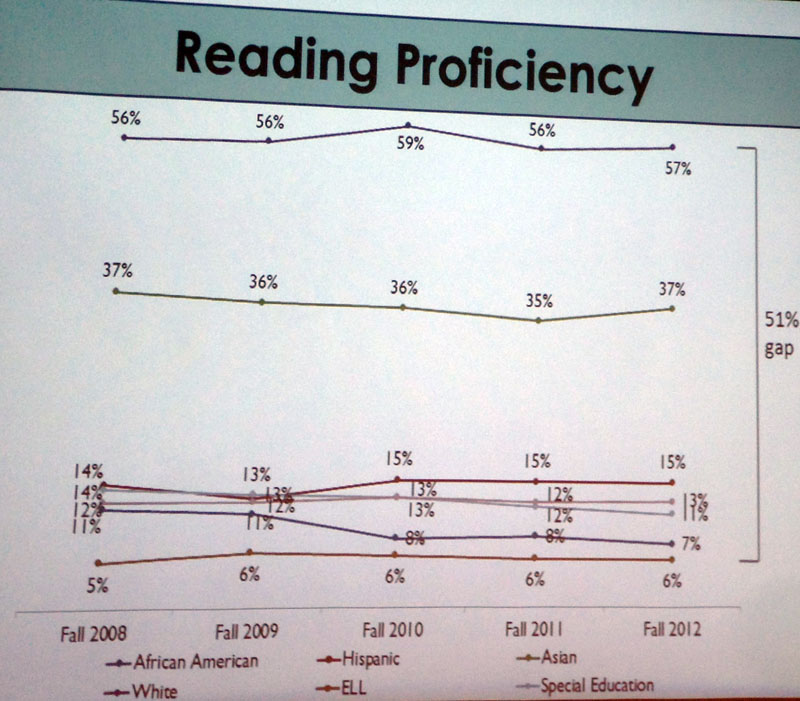
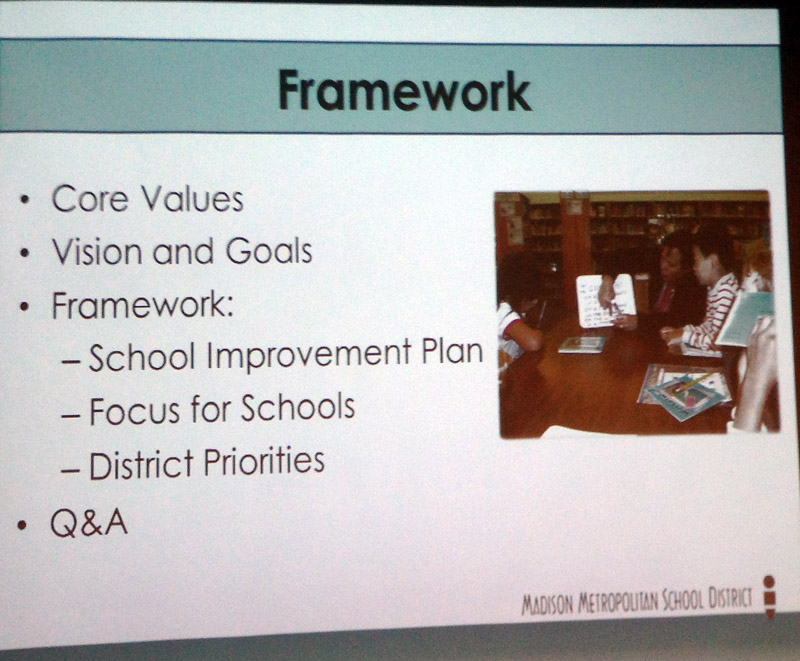
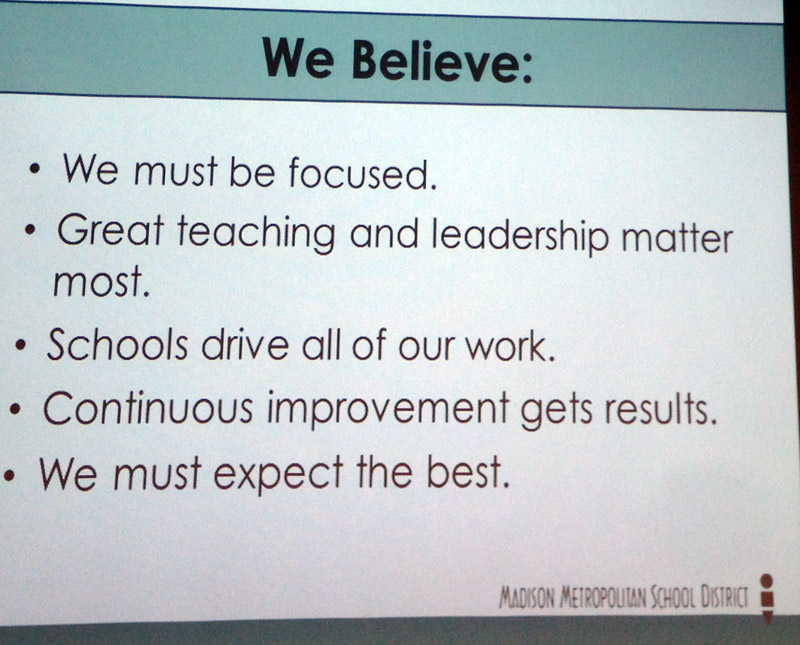
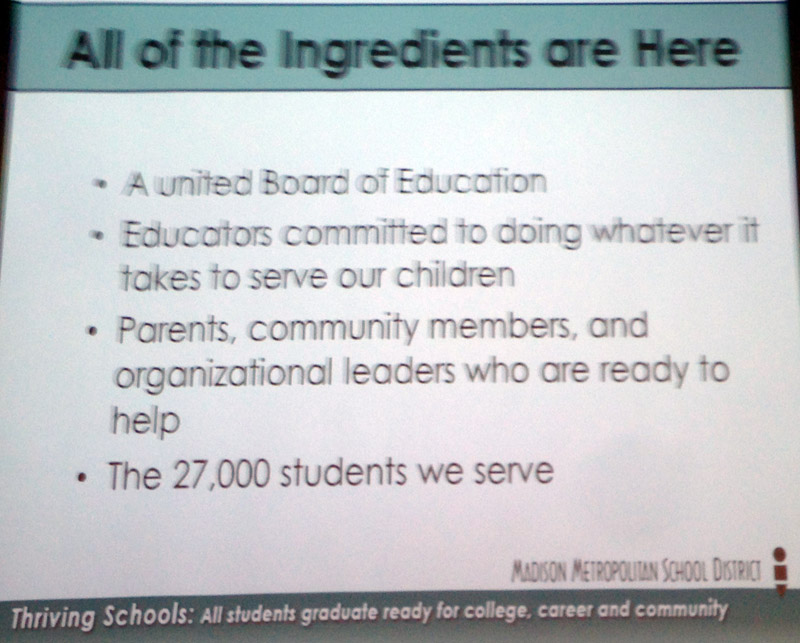
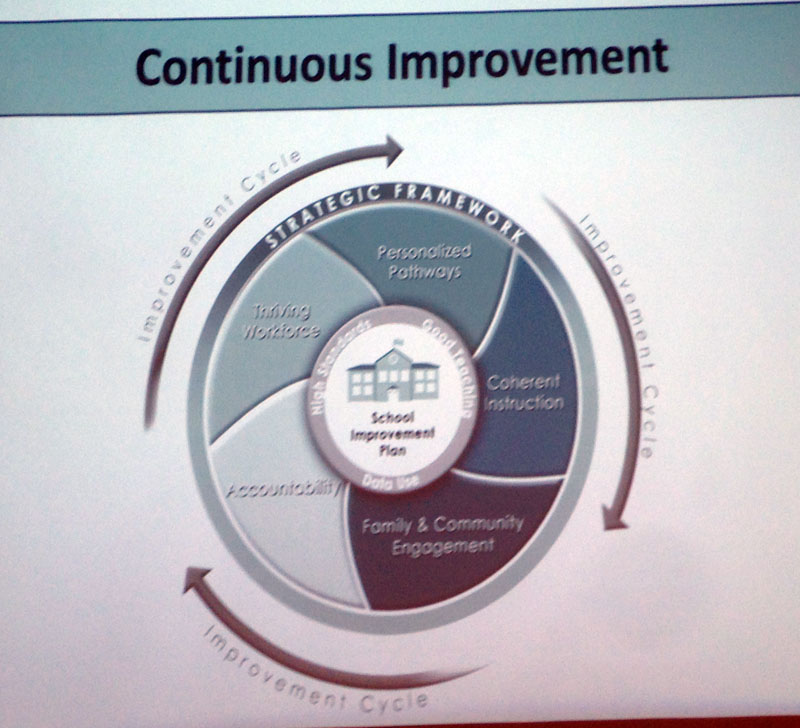
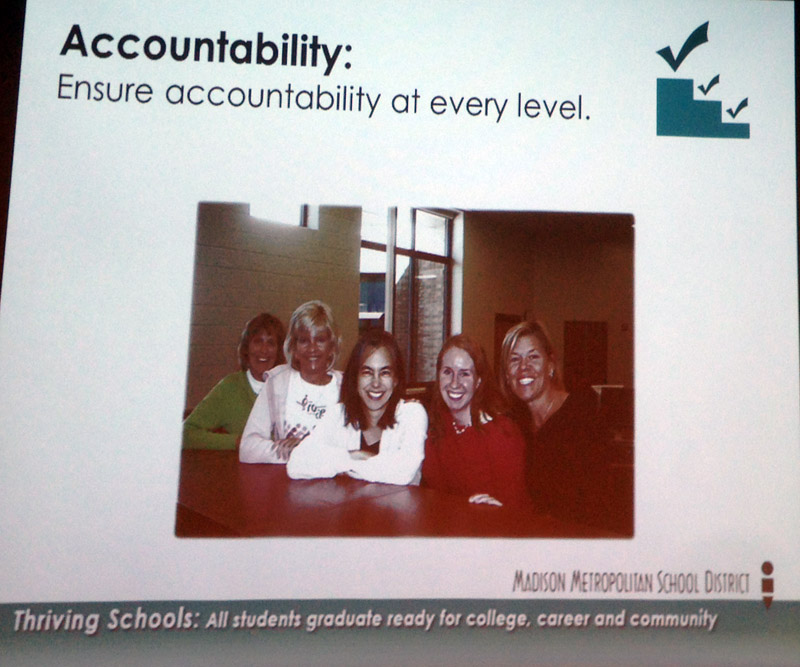
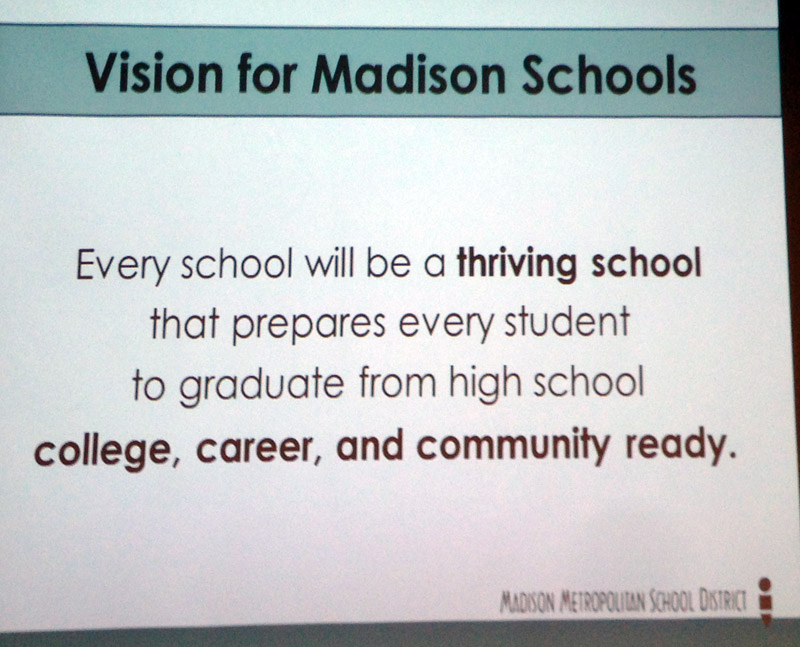
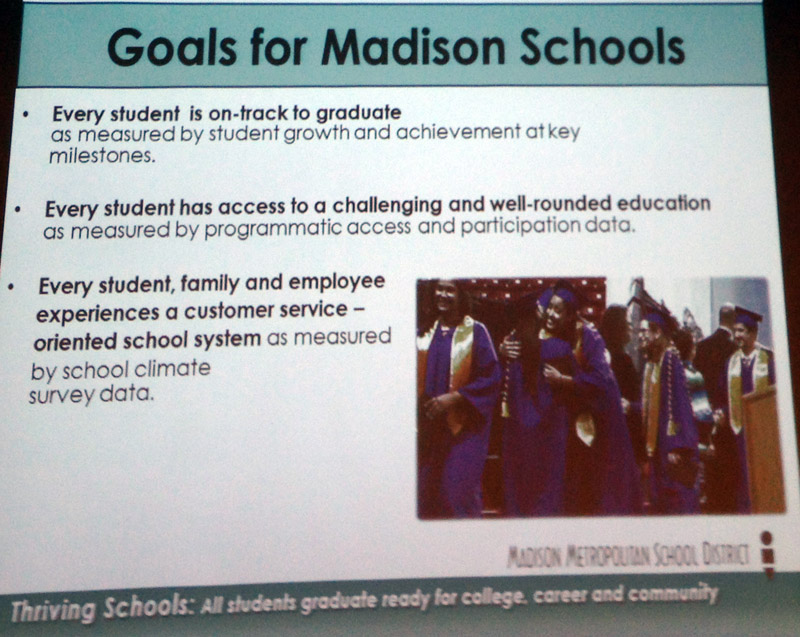
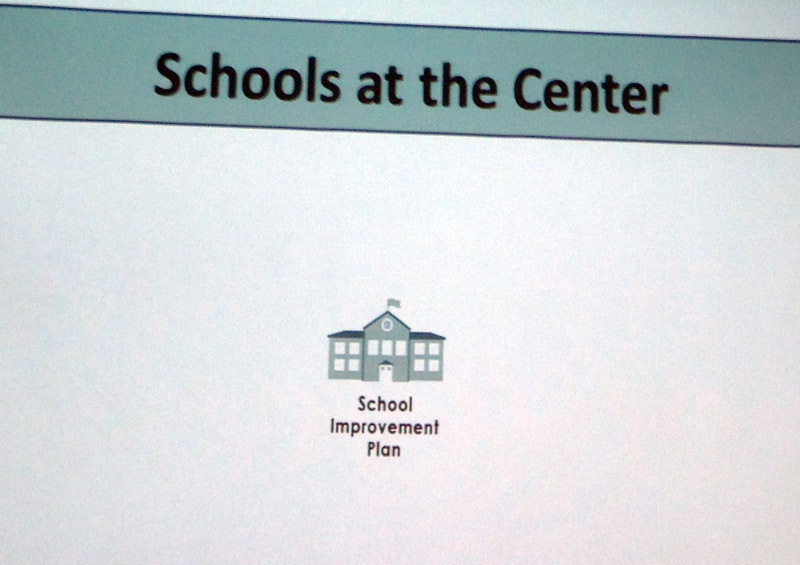
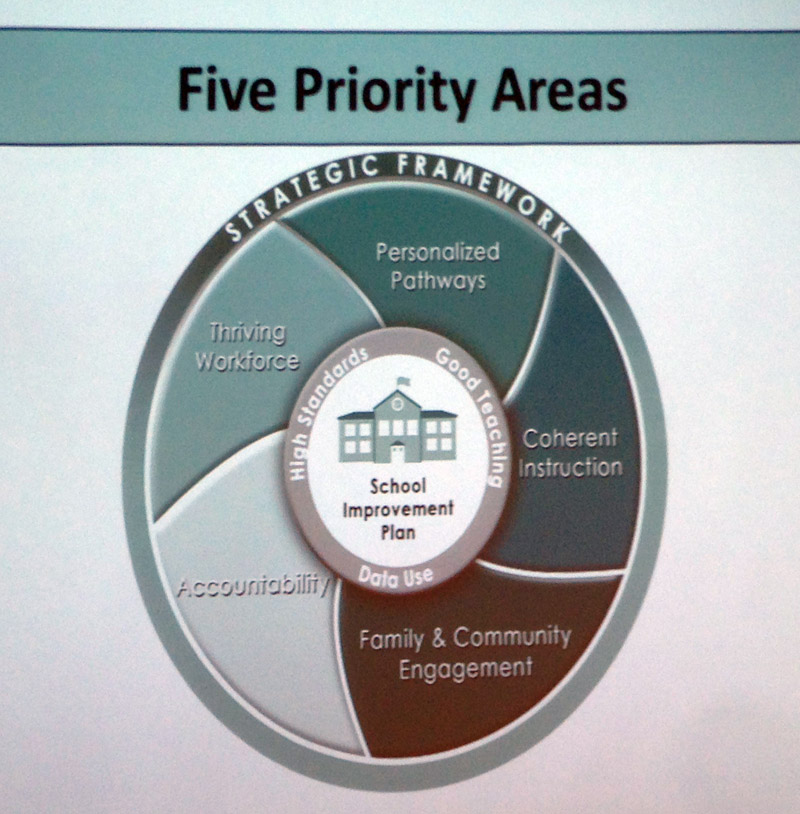
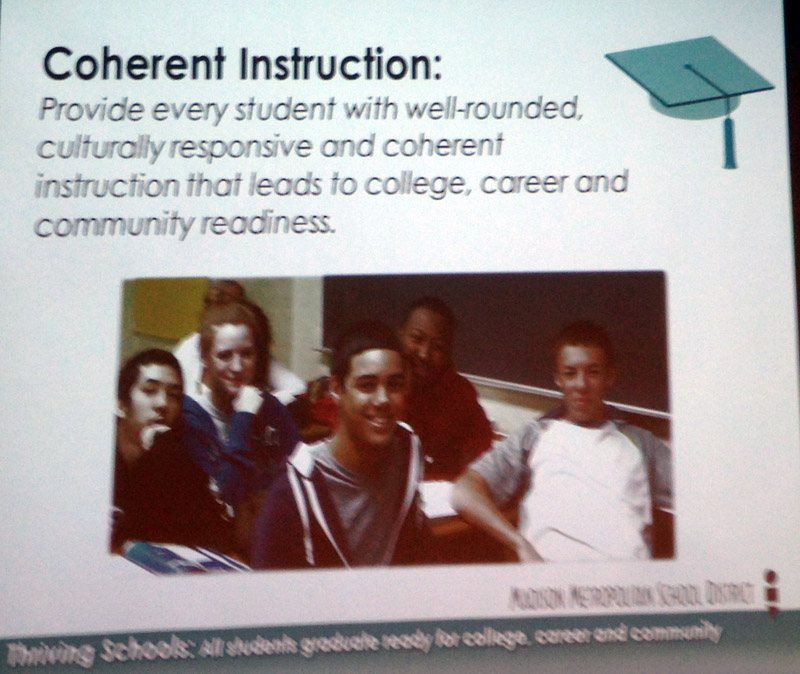
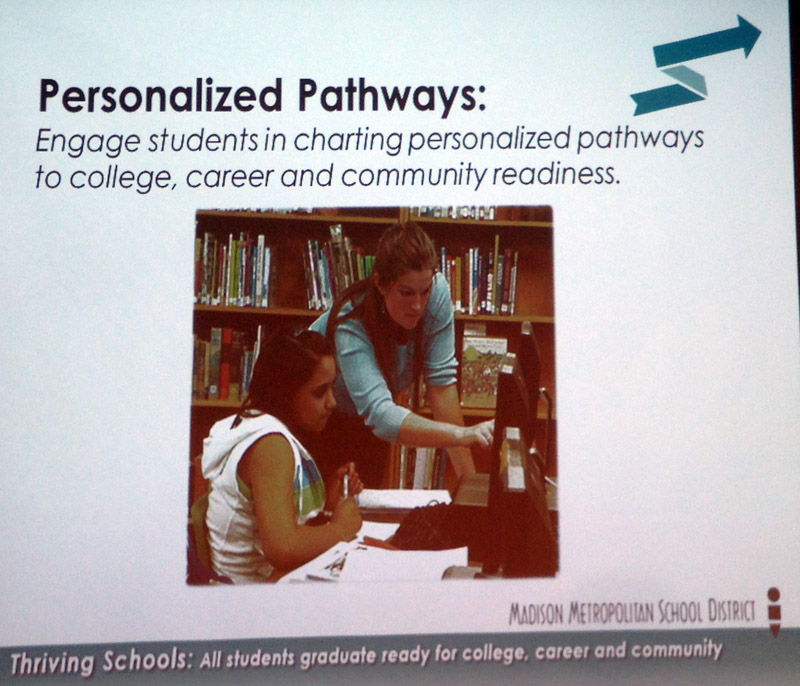
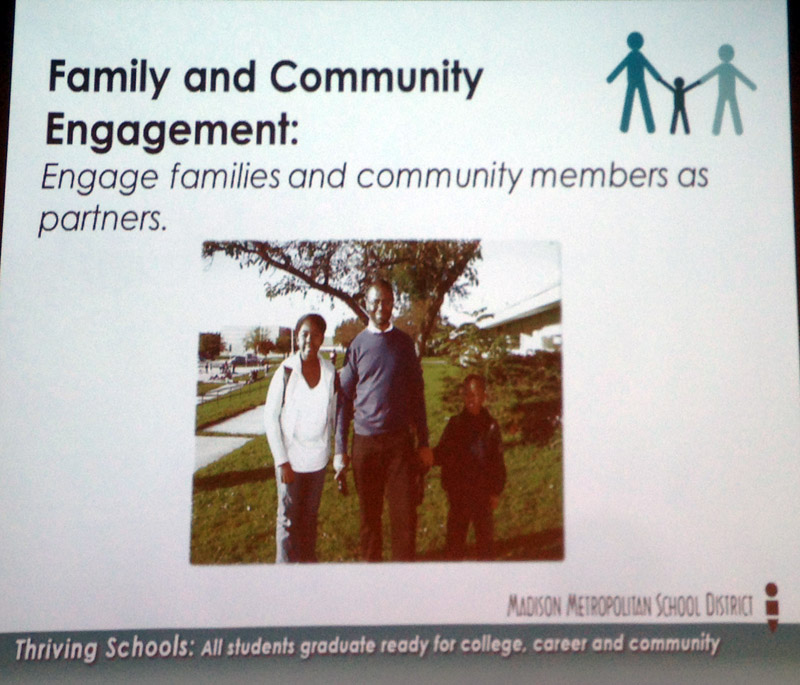

A few of the Superintendent’s words merit a bit of analysis:
1. “What will be different this time?” That rhetoric is appropriate for our Madison schools. I compiled a number of notes and links on this subject, here.
2. “Ready to partner with local businesses and other organizations”. Great idea. The substance of this would certainly be a change after the Madison Preparatory Academy IB Charter school debacle (Urban League) and, some years ago, the rejection of Promega’s kind offer to partner on Madison Middle Schools 2000.
3. Mentions “all Madison schools are diverse”. I don’t buy that. The range of student climate across all schools is significant, from Van Hise and Franklin to LakeView, Mendota and Sandburg. Madison school data by income summary. I have long been astonished that this wide variation continues. Note that Madison’s reading problems are not limited to African-American students.
4. Mentioned Long Beach and Boston as urban districts that have narrowed the achievement gap. Both districts offer a variety of school governance models, which is quite different than Madison’s long-time “one size fits all approach”.
5. Dave Baskerville (www.wisconsin2.org) asked a question about benchmarking Madison students vs. the world, rather than Green Bay and Milwaukee. Superintendent Cheatham responded positively to that inquiry. Interestingly, the Long Beach schools prominently display their status as a “top 5 school system worldwide”.
6. “Some teachers and principals have not been reviewed for as long as 7 years”. This points to the crux of hard decision making. Presumably, we are at this point because such reviews make no difference given rolling administrator contracts and a strong union umbrella (or floor depending on your point of view). Thus, my last point (below) about getting on with the hard decisions which focus the organization on job number one: reading.
Pat Schneider and Matthew DeFour summarize the Superintendent’s press release and appearance.
Finally, I found it a bit curious that the Superintendent is supporting spending (and related property tax growth) for current programs in light of the larger strategy discussed today along with the recent “expert review”. The review stated that the “Madison School District has resources to close achievement gap”
This would be a great time to eliminate some programs such as the partially implemented Infinite Campus system.
Superintendent Cheatham’s plan indicates that choices will be made so that staff and resources can focus on where they are most needed. I wholeheartedly agree. There is no point in waiting and wasting more time and money. Delay will only increase the cost of her “strategy tax“.

schoolinfosystem.org